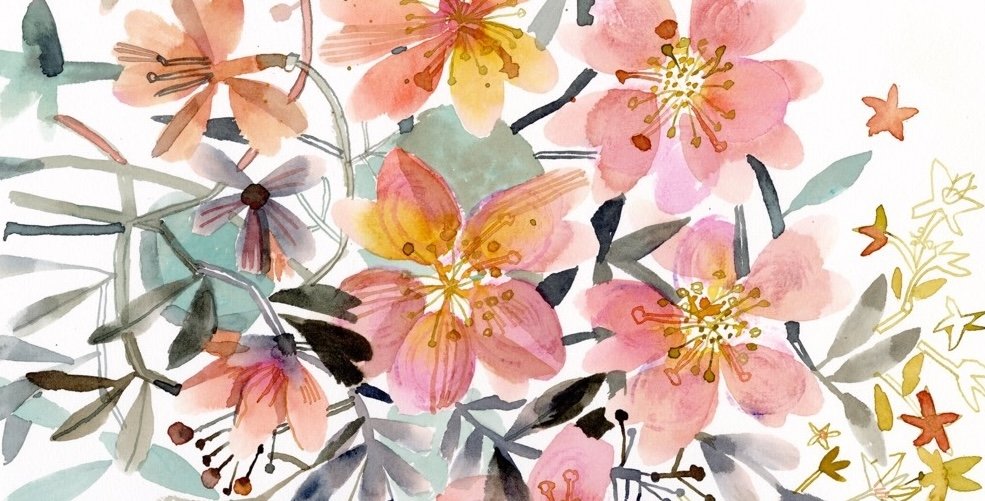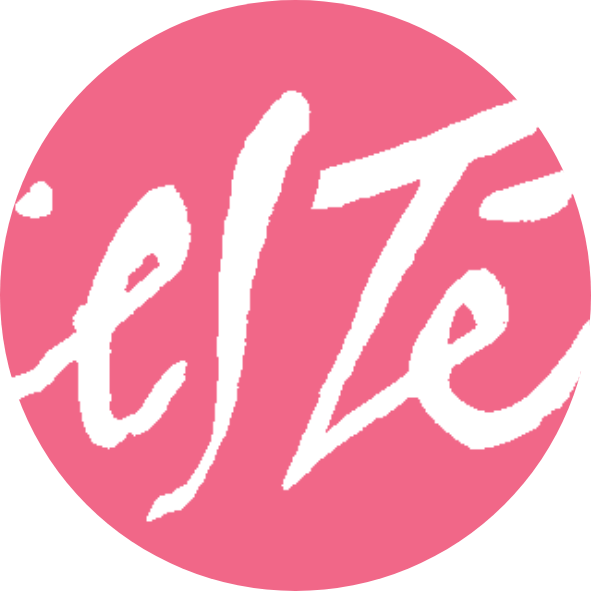
I am so excited to tell you about this new course I've developed around the topics of florals and botanical forms.
Florals have been present in art, design and decoration since the dawn of civilisation. They've been used on stylised depictions of lotuses in Egyptian friezes, on Greek and Roman mosaics and in paintings and decorations in Eastern cultures to name but a few.
They've been part of humanity for millennia and are timeless, reinvented over time to suit each era, genre, whim and fancy. They will never goes out of fashion.
Flowers are a recurring theme in my own art and I have developed Floral Fusion to explore a variety of styles, techniques and processes in watercolour and in combination with other media.
In my practice as a fine artist and designer, I value what I learnt from my original training in textile design, fine art printmaking and jewellery. The design principles, adaption and stylisation of plant forms are part of my signature style and I would love to share processes and techniques with you to help you develop or define your own authentic style.
In Floral Fusion there is a focus on developing and refining individual approaches with an emphasis on the Creative Leap Method™ where handwriting and letters are used to develop a vocabulary of shapes, textures and forms to be used in different floral and botanical projects.
The course has three modules, each one with a different emphasis and inspiration that comes from a variety of sources ranging from ancient folk art and embroidery, to the Arts and Craft movement and zany mid-century abstraction with lots of room for expanding on ideas and developing of individual styles and approaches.
I am not a purist - I love experimenting with a wide range of techniques and processes combining materials. This three week long course comes with permission to play and explore traditional media in new ways in order to expand your own ways of thinking and creating.
Floral Fusion consists of three, week-long modules plus a bonus section at the start where the materials and processes are explained in depth. Within each module, you'll find four projects presented in easy-to-digest portions, one per day, building up to a larger assignment at the weekend. So that's fifteen projects in total, each designed to kickstart ideas and to promote original and imaginative thinking.
A multitude of watercolour and gouache techniques will be explored in Floral Fusion, in combination with acrylic inks and other media, all tailored to the specific module's theme. The course has a structured approach is designed to not only build your skills, but also to guide you in strengthening your own creative voice with a closer connection to your imagination..
Expand your creativity and develop a stronger sense of colour, pattern and form with this alternative drawing and painting course.
During Floral Fusion I’ll show you how to create stylised and imaginary florals and forms by developing doodles, drawings and designs into more complex creations. There's a focus on paint techniques and colour combinations. Floral Fusion is an ideal course to explore watercolour and mixed media and to expand knowledge useful for all art practices.
Who is this course for?
Anyone with a love of colour and an interest in exploring water-based mixed media techniques. The course is suitable for all kinds of artists and creatives with different levels of experience. Drawing is important to explore your own way of creating forms, no need to draw pretty though.
What the course doesn't cover
Super realistic floral and botanical studies. This course is about imagination and mixed media techniques with florals as muse.
Digital art. To get the best out of this course you need to work with the materials as shared in the materials list. Surface patterns and designs created digitally are not explored in this course.
Materials List
Here’s the list of materials you’ll need to get the most out of Floral Fusion.
I’ve recommended the same, quality materials that I use in my daily art practice. Affiliate links for Jacksons in the UK are included but you’re welcome to source from wherever you get your art supplies.
As with all my courses, Arboretum has a list of materials that I curated with careful consideration that we'll use throughout the course. These are the same sketchbooks, paints and brushes that I use. They're all professional quality and are worth the money.
Paper
A basic smooth paper sketchbook for drawing exploration
A watercolour of mixed media paper sketchbook, Moleskine or Hahnemuhle A4 size or similar ledger size paper. You can also work on paper instead of a book as a more economical option.
A watercolour block of A3 size, roughly 12”x16” Cold Press Paper 300g. Arches Aquarelle and Hahnemuhle come in large individual sheets and pre-stretched blocks of ten or twelve sheets
Tracing paper or tissue paper or similar like deli paper or wax paper.
Extra paper for stencils
Paints, Pencils & Inks
A few black pigment ink fineliner markers (must not be water soluble once dry), pencils and other drawing instruments of your own choice.
A pointed dip pen for drawing in ink. .
Acrylic ink, black 30ml. I use Golden High Flow acrylic paint.
Professional quality watercolour set, I use the QoR Watercolour set of twelve tubes for the projects. Please take note of the twelve colours in the set that are required if you use a different brand like Daniel Smith.
Horadam Titanium White water soluble gouache 60ml or 15m made by Schminke. I often use this l to turn watercolour into tinted opaque gouache, I recommend getting the larger tube. (Do NOT get acrylic gouache)
Small container of Dorlands Wax Medium or similar.
Brayer 4" the roller used for lino printing. I use a soft rubber option.
Pink fluorescent fine acrylic marker, 2mm I use Molotow refillable no 217
White acrylic marker Ultra Fine 0.7mm and optional Fine 0.9mm I use Posca, there are other options
An Ink Black or dark green like Mallard/Ionian/Iron Green Derwent Inktense or Caran D’ache’s Museum Aquarelle pencil
Black carbon copy paper (the waxy kind, not graphite paper).
Luminance Pencil Sepia or similar dark colour
Optional: Luminance Pencil Chrysocolla Blue, Light Malachite and Dark Cadmium Orange
Paintbrushes
Paintbrushes suitable for watercolour and acrylic paint. A pointed round synthetic size 10 brush can be used for most projects. I have added a list of brushes below. You do not need all of these, but these brushes are ideal for exploring a variety of textures and marks as demonstrated in the projects by myself
Round pointed, Designer brush size 10 or Silver Utra Round
Fan brush e.g. Blender Size Medium
Dagger or angled brush, size 1/4" Series 311 or Red Dot
Stencil Brush, medium size
Optional: mop brush size large. Golden mop Red Dot size 5
Optional: Angled brush 3/4" or Silver Silk 88
Other Materials
Low tack masking tape (Kleenedge or Tesa)
Removable masking fluid with applicator (not wax based).
Scissors and craft knife
Silicone blender sponge x2
Disposable paper palette and flat containers for mixing paint such as postal tube end caps.
Additional materials required: Regular size balloons. Potatoes (or yams or carrots) for printing.
A bag of baby leaves salad greens, used in module two
Optional: A home printer

